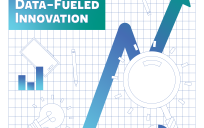 What does it take to win the data wars? How do you ensure you’re extracting true value from data to advance your organization?
What does it take to win the data wars? How do you ensure you’re extracting true value from data to advance your organization?
Data science is the art (and science) of extracting insights from data to inform decisions. Organizations that lead with data science are achieving greater productivity, increasing ROI, and driving improved performance and competitive advantage. Data science is the key to understanding the past, predicting future trends, and taking optimal action.
When there is no shortage of data, how do you get from massive data to mission success?
Think Big. Start Small. Learn Fast.
For starters, devise a grand plan. The best data-enabled organizations have a clear strategy for moving forward. Establishing the goals of the enterprise and the intended outcomes make all the difference in leveraging data science for discovery, innovation, and even societal good.
My work with many organizations follows the ADAPT+C framework for success, consisting of six critical elements:
- Analytic Opportunities
- Data
- Analytics Techniques
- People
- Technology
- Culture
Prioritizing these six elements instills a data science foundation for lasting success through the following considerations:
- Analytic Opportunities: consider new and existing data science use cases to achieve mission goals and to improve operations.
- Data: consider opportunities to use new data and to re-use existing data sets in data science projects.
- Analytics Techniques: consider the analytic tradecraft to be applied to generate insights from data.
- People: consider the set of human capital programs required to develop the talents and capabilities of your data science team.
- Technology: consider ways to optimize existing and new technologies including applications, data platforms, and infrastructure for data science projects.
- Culture: consider the set of mechanisms that communicate, share, and reinforce the value of data science across an organization and that promote data analytic thinking and activities across the workforce.
The most effective organizations prioritize these six ADAPT+C elements to grow their data science capabilities. Do not short-change Culture. Building a culture of experimentation is not only a good data-enabled business practice, but it is also a “data science innovation” best practice— it optimizes value, while helping to attract and retain the best talent.
Ask the Right Questions
When considering analytics opportunities, consider what you really want to do. Are you seeking operational efficiencies, market knowledge, better customer service, new products, or smarter processes? To get valuable outcomes, you need to assess opportunities within the context of the business questions they resolve.
Generating ideas for analytics projects should be built into your strategy. You want to solicit and review all kinds of ideas and formalize a process for collecting and assessing them. Often the best ideas for data science projects sit deep within the organization. You need mechanisms to bring these ideas forward—get the concepts from the people that know the work and the business best. What kinds of mechanisms work best?
One approach is to task a centralized group to scan organizational data for opportunities. For clients who are currently lacking robust data tools or a data-enabled culture, we created Analytic Innovation Cells (AIC) to prove the value of data science with quick wins. Quick wins demonstrate value and the ROI that will inspire the cultural change needed for the larger analytic implementations that will come. Check out an example of how an AIC was used to generate out-of-the-box methods, tools, and processes to keep nations safer.
Other ways to percolate up innovative ideas and data analytics opportunities in the organization include open forums, digital crowdsourcing tools, and hackathons. These events invite a steady stream of ideas from employees and foster engagement around data science. These work best in organizations that have existing analysts on staff, or access to them. Incubators and venture programs are also great ways to discover and assess the best opportunities for data science.
Deciding which ideas to implement is another matter. Again, it comes back to establishing the right questions you want to answer, and then prioritizing the opportunities that will best answer those questions and thereby advance the organization’s mission and capabilities.
Manage Analytics Projects with Rigor
A successful data analytics strategy will include methods for evaluating a pipeline of ideas and prioritizing the most relevant ones. Like any capital investment, you must work toward objectives by defining the criteria for success and setting realistic timelines and budgets.
As opportunities take shape, rigor in defining the scope, cost, and timeline for each data science project mitigates risks and keeps projects moving forward. Even when you’re using a DevOps approach and relying on Agile methodologies, tight project oversight will both encourage data exploration and allow for course correction along the way. We call this DataOps, which is one of the ten signs of data science maturity in organizations.
Building an enterprise-wide portfolio of data science projects should be on every organization’s agenda. Constant review of efforts ensures consistent alignment to the organization’s goals through effective data analytics portfolio management while capitalizing on your strongest capabilities, and building new ones.
Put it All Together
Data science is the engine (scientific methodology). Analytics are the products (outputs). Data are the fuel (inputs). Therefore, success in data science projects comes down to the inputs and the outputs—how an organization ingests and organizes structured and unstructured data, and knowing which analytics tradecraft are best to analyze, visualize, contextualize, and discover insights within that data.
Every organization is different with its own unique data environment, architecture, business, and data needs. Knowing where to start is also unique. Consequently, it is best to start small, in order to learn fast, while also thinking big. Break those big projects into smaller pieces—refine and learn from each piece. This will help you to have better insights into which technologies, staffing, and other resources will be needed for the larger analytic implementations to come.
With so many opportunities ahead, and so much potential to realize, investing in a data analytics strategy can make the most of your resources to meet pressing needs. With so many variables to consider, learn more about how to ask the right questions, make a plan, and get started by examining the Field Guide to Data Science, a primer with tips and techniques to build the foundation for data-driven success. Another helpful source for organizations is this excellent MBA course textbook: “Data Science for Business: What you Need to Know about Data Mining and Data-Analytic Thinking”. A surprisingly good and comprehensive coverage of the various algorithms and techniques of data science can be found in this book (whose title might surprise you too): “Data Mining Techniques: For Marketing, Sales, and Customer Relationship Management”.
Dr. Kirk Borne is a GovLoop Featured Contributor. He is the Principal Data Scientist and an Executive Advisor at management consulting firm Booz Allen Hamilton since 2015. In those roles, he focuses on applications of data science, data management, machine learning, and AI across a variety of disciplines. You can read his posts here.





Leave a Reply
You must be logged in to post a comment.